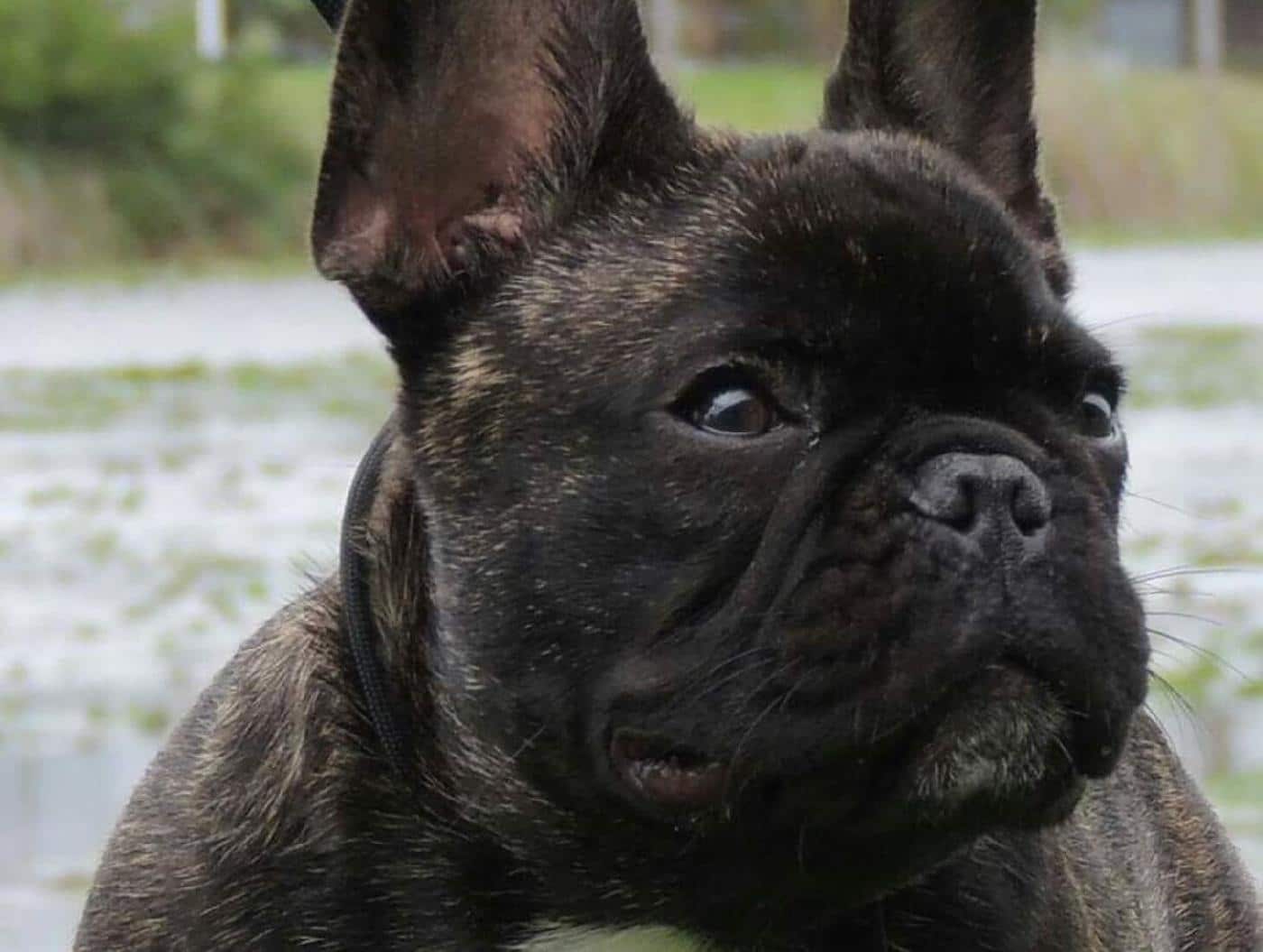
Home » The Many Manifestations of Brindle in French Bulldogs

As every fancier knows, the French Bulldog comes in a wide variety of colors and patterns—some of which are acceptable according to the AKC standard and others that are not.
The colors found in the French Bulldog are masked fawns, fawns, and creams. The patterns found in French Bulldogs are piebald and brindle.
Urajiro markings (pale tan or cream to white markings similar to the tan points on black and tan dogs—except they appear in fawn color coats as well as in black and tan coats) are also known to occur in French Bulldogs, but are extremely rare.
Tan point and cross-bred merle Frenchies are favorites of “color breeders.” The alterations to pigment caused by the autosomal recessive genes on the D (Dilute) Locus and B (Brown) Locus, much sought after by color breeders and commonly referred to as “blue” and “chocolate” or “liver,” have the ability to alter the appearance of each of the patterns and colors previously noted. It is enough to make a breeder’s head spin, so it is best to start the exploration of coat color genetics with the most common color/pattern found in French Bulldog dogs—brindle.
As a starting point, it is important to note that all brindle dogs are genetically yellow, a result of inheriting a dominant gene for yellow at the A (Agouti) Locus as well as a dominant gene for masked fawn or fawn at the E (Extension) Locus. The combination of these genes allows for the expression of pheomelanin, or red/yellow pigment, while also permitting black pigment in the coat. All brindle French Bulldogs would be a masked fawn or fawn if a brindle gene had not been inherited.
The brindle pattern normally appears as black stripes (the result of the black pigment eumelanin) which partially extend over the body of the dog. The stripes can vary in quantity from a few to very many. Dogs can have so few or such faint brindle markings that they may not be recognized as being brindle. Such dogs are called “cryptic brindles,” and will be registered as masked fawns or fawns, and will produce brindle offspring.
Alternatively, dogs may be so heavily marked that they may appear to be black. There has always been concern that the very heavily marked brindle Frenchies might somehow or another mutate to black, so the standard disqualifies what appears to be black French Bulldogs. It is important that French Bulldogs have enough fawn hair to satisfy the standard requirements.
To determine whether or not fawn hair is present, look closely at individual hairs on dogs that initially appear to be completely black. If light colored hairs are seen—however sparse they might be—then it is evidence of the underlying fawn color.
This is especially important in evaluating heavily brindled pied dogs. A stripe pattern in the lighter colored hair is not required to satisfy the standard, nor are light colored hairs required in each brindle spot of a brindle piebald. In addition, there are “seal brindle” French Bulldogs just as there are seal Boston Terriers, where the fawn and black hairs are so evenly distributed and intermixed that the dog appears to be an off-black color.
Clearly, there are modifying genes that control how much black eumelanin brindling is extended over the body of the dog. In French Bulldogs, a darker appearance is preferred and is often referred to as “black brindle,” as opposed to “reverse” or “stripey” brindle. The problem is that these terms don’t necessarily mean the same thing in other breeds of dogs. A term such as “lightly marked” or “heavily marked” brindle is more understandable across the breeds of dogs in which the brindle pattern occurs.
We now turn to how the black eumelanin of the brindle pattern can be affected by the dilute (blue) and brown (chocolate, liver) genes. The dilute and brown genes are recessive at their respective gene loci to the dominant gene for black pigment. The inheritance of one dilute or brown gene does not alter the appearance of the black pigment. However, if two dilute genes or two brown genes are inherited then the ability of the dog to produce black pigment anywhere on its body is prevented.
These genes are so powerful that not only the black pigment in the coat is altered; the black pigment of the nose, lips, eye rims and pads is altered as well. In many breeds of dogs, those with brown or dilute pigment are called self-colored since the color of the nose and the color of the coat are the same. However, this generally refers to dogs that would otherwise be black. The brown and dilute genes also have the ability to lighten the coat color of fawn and cream dogs and, in the case of cream Frenchies, the nose color may be close to pink.
When two brown genes and two dilute genes are inherited, the resulting color is called Isabella. Color breeders call this color “lilac” after the color found in Siamese cats that is caused by the same genes. Cream Frenchies with Isabella pigment will have a very noticeable lightening of the nose color, exceeding that of brown or dilute dogs, with masked fawn, fawn and brindle dogs also showing the increased change in nose pigment.
The gene for brindle is thought to be located on the K (blacK Locus). The gene considered to be the most dominant of the three genes found here is the gene for dominant black. Brindle is a step down in dominance, and dogs can inherit both a black gene and a brindle gene—it’s just that the brindle pattern cannot be seen in the black coat.
Brindle markings can appear in the tan points of black and tan dogs, and color breeders call these dogs “trindles.” The recessive gene located at this locus is a gene for yellow. All dogs that are cream, fawn or black mask fawn are also homozygous for yellow at the K Locus. Regrettably, at this point in time the brindle gene has not been located and a genetic test does not exist to confirm whether or not a dog is a cryptic brindle.
The brindle gene is recognized as a dominant gene since only one gene has to be inherited for the trait to be expressed. If a Frenchie inherits two brindle genes then it is said to be “pure for brindle,” with the genetic term being homozygous for brindle. Such dogs, regardless of the color or pattern of any mate, will only produce brindle offspring—the only exception being that a completely white puppy could be produced providing both parents were able to contribute a gene for extreme piebald. Such a puppy would still inherit a brindle gene and would produce brindle puppies.
Brindles that are able to produce masked fawns, fawns, and creams have inherited only one brindle gene, and will produce brindles 50% of the time if bred to a masked fawn, fawn, or cream. A cross of two heterozygous brindles will produce masked fawn, fawn or cream puppies 25 percent of the time. Finally, any time a brindle dog has both a brindle parent and a masked fawn, fawn or cream parent it will automatically be heterozygous for brindle. Knowing how brindle is inherited is advantageous to breeders who would like to be able to predict the anticipated colors/patterns of planned breedings.
No article on brindle would be complete without a discussion of the phenomenon of brindle puppies born to two non-brindle parents. In the absence of a genetic test for brindle, there are two possible explanations.
The first explanation is that one of the parents is a cryptic brindle, which was previously discussed.
The second requires that one of the parents be homozygous for restriction of pigment at the Extension Locus; such dogs would be recognized as a red fawn, fawn or cream dog and would be identical genetically to Irish Setters, Golden Retrievers and yellow Labs.
The combination of two restriction of pigment genes is so powerful that it prevents the expression of any eumelanin (black pigment) in the coat—even if the dog has inherited a dominant black or brindle gene at the K Locus. We don’t tend to think that dominant black or brindle can be “hidden” by other genes, but this combination occurs in several breeds of dogs and can provide a big surprise if the French Bulldog dog is bred and produces completely unexpected colors/patterns.
In genetic terminology, the two restriction of pigment genes are said to be epistatic to either the dominant black or brindle genes. While this explanation certainly is true for some breeds of dogs, I don’t think it is true for French Bulldogs very often due to the preference for brindle that would select against the restriction of pigment gene, and direct descent from Bulldogs that are virtually all masked fawns.
Finally, I appeal to all fanciers to focus on our coat color vocabulary to facilitate communication between heritage breeders and to distinguish us from color breeders. Our standard still uses the historic words “mouse” and “liver,” which are not clear in their meaning and can easily be misinterpreted. My first suggestion that was previously mentioned is to use the adjectives “lightly” or “heavily” marked when describing the amount of brindling, instead of the terms reverse or black brindle.
Secondly, when describing alterations in pigment that are a disqualification, use the genetic term “brown” instead of the common terms liver or chocolate and the term “dilute” instead of the common term blue. When speaking of dogs that are both dilute and brown, use the term Isabella instead of the common term lilac.
You will be recognized as someone who knows the genetic basis for coat color and patterns and will be instantly set apart from color breeders when you describe brindle dogs as “heavily marked brindle,” “heavily marked brown brindle,” “lightly marked Isabella brindle,” or “moderately marked dilute brindle.” Let’s leave the terms chocolate, blue, and lilac to color breeders and focus on aligning our vocabulary with the genes involved to establish a coat color vocabulary based on science.
The Many Manifestations of Brindle in French Bulldogs – Showsight Magazine August 2020 Issue
Showsight Magazine is the only publication to offer dedicated Digital Breed Magazines for ALL recognized AKC Breeds.
Read and learn more about the adaptable French Bulldog dog breed with articles and information in our French Bulldog Dog Breed Magazine.
Error embedding FlippingBook shortcode, please check the flipbook url. (https://digital.showsightmagazine.com/view/931293/)